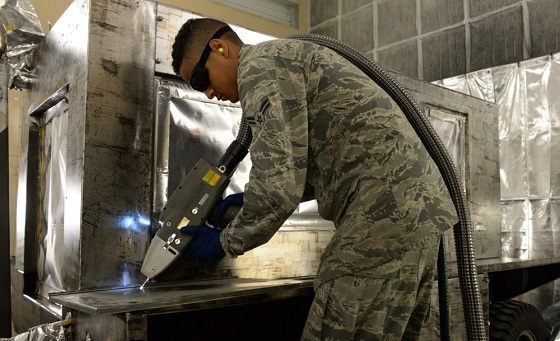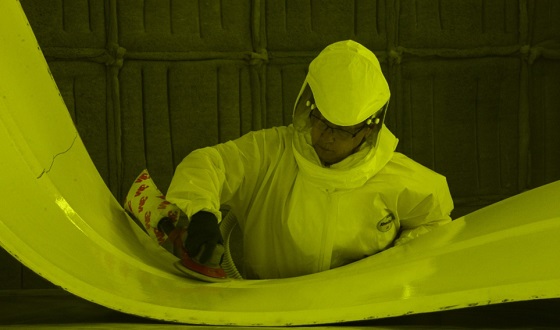U.S. Airmen with the 60th Maintenance Squadron (MXS) at Travis Air Force Base in California are beta testing neodymium-doped yttrium aluminum garnet (Nd:YAG) lasers to remove paint and corrosion on aerospace ground equipment.
The 60th MXS is one of only two bases chosen to test the 1,000-W Clean Laser 1000 (Laser System CL 1000) and the 300-W Clean Laser 300 (Laser System CL 300) from laser cleaning units provider Adapt Laser Systems (Kansas City, Missouri, USA).1
“The main difference with this laser is that it can remove corrosion without removing metal,” says Tech. Sgt. Brian Brown, aircraft structural maintenance corrosion manager for the 60th MXS. “Sanding and grinding remove additional material, while the laser burns off corrosion without taking any metal with it.”
The new laser method could also lead to a safer workplace with reduced personal protective equipment (PPE) needs for maintenance crews, since less material is removed.
Technical Advantages
Overall, the system creates a safer and more efficient way to navigate corrosion in equipment, according to staffers who have been beta testing the system since 2017.

“We cannot use paint remover, so we have to use sanders,” says Senior Airman Troy Chuckran, an aircraft structural maintenance journeyman with the 60th MXS. “When you are sanding, you can’t always tell how much paint material you are removing. You tend to blend the crack, which causes the severity of the corrosion to be covered up and be discovered by the [nondestructive inspection team]. With the lasers, you’re not removing surface or polishing the surface, you are only removing paint and corrosion.”
The lasers are currently being used on all support equipment for the airframes at Travis, such as air conditioning units, hydraulic carts, and a power generator, which provides power to the aircraft. These same tests are currently being performed on old panels from a C-5M Super Galaxy aircraft model.
“I see the lasers as the future of removing paint and corrosion,” Chuckran says. “It will definitely have a huge impact once we can begin using them on the aircraft.”
PPE, Safety Benefits
Besides the enhanced technical features, the Air Force has also found additional safety benefits by using lasers instead of hand sanders.
“Our traditional method is to use an orbital sander or blasting machine,” Brown says. “For the orbital sander, you have to be suited up in a full Tyvek suit, full-face respirator, force air respirator, and nitrile gloves.” The Tyvek coverall suits, which are completely air-sealed and hooked up to oxygen to protect workers from chemicals released during the sanding process, are manufactured by DuPont (Wilmington, Delaware, USA).

While sanding and blasting operations put carcinogens in the air, the laser includes a built-in vacuum. As it removes the substrate, it sucks up particles and keeps them out of the air. Since the Air Force uses a primer with chromate in it, the lasers help to minimize the waste stream.2 In all, the Air Force estimates that the laser reduces the waste created from sanding paint by 90%.
For staffers, tests were performed to ensure the proper PPE was identified for the lasers. “We did a week’s worth of testing to determine what type of PPE is needed while using the laser,” Chuckran says. “We had to be fully suited up, we took air samples, and used the laser to collect data while testing the air quality to make sure we are safe.”
The tests resulted in another improvement when compared to the hand sanders. “Now we don’t wear the Tyvek suit,” Chuckran explains. “All we need are specialized glasses, hearing protection, and gloves. It’s a major improvement, especially in the summer when the Tyvek suit becomes a sauna suit.”
Source: U.S. Defense Video Imagery Distribution System, www.dvidshub.net.
References
1 “Travis Beta Tests Lasers,” Defense Visual Information Distribution Service News, March 12, 2018, https://www.dvidshub.net/news/269094/travis-beta-tests-lasers (Feb. 18, 2019).
2 “Technology of the Future,” 349th Air Mobility Wing News, April 25, 2017, https://www.349amw.afrc.af.mil/News/Article-Display/Article/1162030/technology-of-the-future (Feb. 18, 2019).